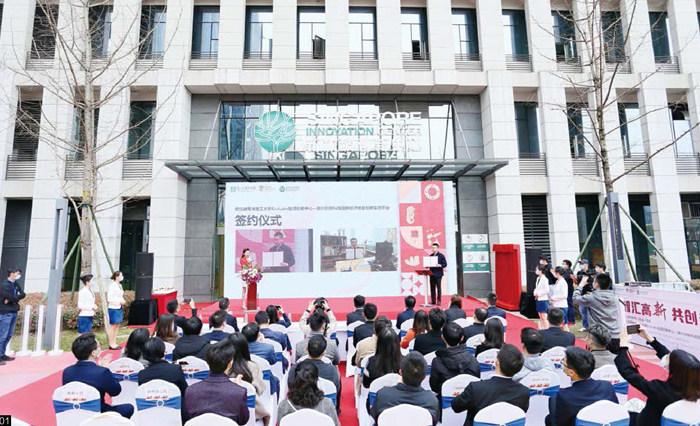政产学协同推动东盟实现能源转型
2022-03-14阿尔弗雷德·古宁里斯基·普特拉莎妮娅·马纳洛
阿尔弗雷德·古宁 里斯基·普特拉 莎妮娅·马纳洛

东盟想在东南亚建立单一市场一体化,由此带来的经济快速增长导致能源需求不断上升,能源问题亟待解决。
根据《第6版东盟能源展望》,到2040年,东盟能源需求将会大幅上升,增幅达146%。除了能源安全问题,能源需求上升还会导致温室气体排放量增加,预计到2040年达到4171吨二氧化碳当量。保持能源需求稳定是该地区的重大关切,尤其是在当地受气候变化影响环境脆弱的情况下。
为了解决问题,东盟各国能源部长支持通过了区域能源发展蓝图,即第二阶段《东盟能源合作行动计划》(2021-2025年),各国一致认同创新是区域实现能源转型、能源安全和能源可持续发展的关键因素。
在《东盟能源合作行动计划》框架下,东盟制订了一系列措施,促使利益相关方挖掘创新潜力,实现地区宏伟目标,包括降低32%的能耗强度、到2025年将可再生能源在能源结构中的比重提高至23%。
东盟实现能源转型需要政府、产业和大学的共同努力和合作。
研究发现,三螺旋模型通过“政府机构”“商业模式创新”“财务现金流”三位一体来解决能源项目的价值创造,从而推动战略创新。
作为一种决策工具,这一模型在政府、产业、大学中应用广泛。
政府、企业、大学都是三螺旋的重要成员:大学承担研发工作,产业推动研究成果商业化,政府负责规范相关市场。三者在这一模型下相互作用,推动创新合作向纵深发展。
政府决策和目标固然重要,但政产学协同为实现清洁能源系统竞争优势的战略创新提供了一个有意义的框架。此外,通过三者合作创建可持续的能源—气候关系,有利于推动清洁能源的使用。
但东盟当下的三螺旋倡议,无论在国家还是区域层面,仍需提升才能达到最理想的效果。问题的根源在于该倡议并未把政府、产业、大学三者融合起来,而只关注其中一者或两者。这种单边或双边关系削弱了东盟推进能源转型的潜力。
例如在泰国,研究显示尽管政府为加强产学合作做出了努力,但这种合作似乎严重依赖教育。在马来西亚,尽管根据《2013年马来西亚教育、科学和创新指数报告》,该国在144个国家的产学研发中排名18,但对制造业的研究表明,和产业、社区的联系仍不如预期广泛。
在区域层面,政产学三者融合不够紧密的问题同样存在,尽管已经有了明显改善。2021年,东盟能源商业论坛下设的第一届东盟能源和环境国际论坛首次有了大学的参与。东盟能源商业论坛是决策者和行业领袖共同参与的高水平能源会议,其下设的能源环境论坛则是该地区第一个研究能源气候相关问题的科学会议。
尽管取得了这一里程碑式的成果,但实现更大范围、更切实具体的政产学融合仍任重道远。
政产学合作的标准解决方案和最佳载体就是建立合作研究中心,将其作为一个独立的政府机构或项目,直接有效地将三者联系起来。
一些发达国家,如美国、日本、西班牙、意大利等已经采取了这一做法。地区内,新加坡最近成立了自己的合作研究中心Ecolabs,致力于推动能源发展。印尼也提出了发展合作项目,如Pasikola,旨在减轻城市交通负担。
成熟先进的研究中心能有效激发创新,并在国家层面上推动制定可持续的能源政策。由新加坡能源创新中心EcoLabs负责的一个旗舰项目利用初创技术和社区建设可持续的初创城市,旨在比现代大城市消耗更少的能源、水资源、食物和土地。
2021年9月30日,东盟成立了洁净煤技术卓越中心,将其作为洁净煤利用的区域合作研发中心,以提高效率和环境容受性。
2019年,东盟能源中心还启动了两个网络中心,促进该地区工程研究所、学术机构和决策者在增强可再生能源和生物能源专业知识方面的合作。
東盟新兴的合作研究中心和计划能否和其他老牌的研究中心一样收效甚多还有待观察。
东盟需要在第二阶段《东盟能源合作行动计划》框架下,推动实现更大规模的政产学合作,充分发挥东盟能源中心的关键作用,助推区域内的同类合作。
毫不夸张地说,只有扩大政产学合作,东盟才能最大程度实现能源转型,恢复韧性,走上繁荣之路。政府、产业和大学必须继续共同努力,解决共同面临的能源挑战。
来源:《东盟邮报》
编译:陈志莹
本文仅代表作者观点,不代表本刊立场
As the ASEAN Economic Community (AEC) aims to create a single market integration in Southeast Asia, rising energy demand arising from rapid economic growth will need to be addressed.
According to The 6th ASEAN Energy Outlook, ASEAN’s energy demand will increase substantially by 146% by 2040. Aside from energy security issues, the aftermath of this rising energy demand is the increase in greenhouse gas (GHG) emissions, potentially reaching 4,171 Mt CO2-eq in 2040. Therefore, it is a significant concern for the region to sustain the rising energy demand, especially concerning the vulnerability due to the climate change impact in the area.
To address these concerns, the ASEAN Energy Ministers endorsed the regional energy blueprint, ASEAN Plan of Action for Energy Cooperation (APAEC) Phase II: 2021-2025, where ASEAN agreed that innovation is a highly crucial component in balancing the region’s energy transition, security, and sustainability.
Under the APAEC, ASEAN has set out strategies that enable relevant stakeholders to tap into the potential of innovations for achieving a regional aspirational target, including 32% of energy intensity reduction and 23% share of Renewable Energy (RE) in the energy mix by 2025.
The pathway to ASEAN’s energy transition requires conjoined efforts and cooperation from the Government, Industry, and Academe.
Research has found that triple-helix contexts can contribute to strategic innovation by the cross-disciplinary trinity of “organization”, “business model innovation” and “financial cash flow” to address value creation on energy projects.
The triple-helix model has gained prominence as a policy-making tool among the three sectors — Government, Industry, and Academe.
Each sector plays a prominent role, with Academe undertaking research and development, Industries accelerating the commercialisation, and Governments regulating the relevant markets. The model involves the three sectors collaboratively interacting to enhance innovation and cooperation further.
While government policies and targets are essential, it is shown that triple-helix discussions provide a meaningful frame to achieve strategic innovation for the competitive advantage of a clean energy system. Moreover, it is possible to boost clean energy adoption by implementing triple-helix cooperation to create a sustainable energy-climate nexus.
However, ASEAN’s existing triple-helix initiatives at the national and regional level still have significant potential for improvement to reach the optimum output. The problem stems from the initiatives lacking a comprehensive integration of the three sectors, with initiatives only spotlighting either one of the two sectors. These one-sided or bilateral relationships diminish the potential of advancing energy transition for ASEAN.
In Thailand, for example, research has shown that although the government has made efforts to strengthen the university and industry collaborations, the collaboration seemed to rely heavily on education. In Malaysia, although based on the Malaysian Science, Technology, and Innovation Indicators Report 2013, the country ranked 18th out of 144 countries in terms of University-Industry in R&D — research on manufacturing industries shows that engagement levels with the industries and community is still not as extensive as expected.
The exact minimum integration of all three sectors is observed at the regional level, albeit a noticeable improvement. For the first time, the 2021 ASEAN Energy Business Forum (AEBF), a high-level energy conference for policymakers and industry’s business leaders, involved the academes through the 1st ASEAN International Conference on Energy and Environment (AICEE). AICEE served as the region’s first scientific conference to share recent research on energy and climate-related issues.
Despite this milestone, a greater and concrete trilateral integration of the three sectors needs to be pursued.
A standard solution and a preeminent vessel for triple-helix cooperation are establishing a Collaborative Research Centre (CRC), an independent governmental agency or programme, directly and efficiently linking the three players.
This has been done by several developed countries such as the United States, Japan, Spain (Gijon), and Australia. Within the region, Singapore has also recently established its CRC specifically for energy development — the EcoLabs, and Indonesia have initiated several collaborative programmes, such as the Pasikola project.
Mature and progressive research centres have proven to trigger innovation and act as a driving force for sustainable energy policies at the national level. One of the Flagship projects, conducted by EcoLabs Singapore, involves stimulating and building a sustainable start-up city with start-up technologies and communities that aim to consume less energy, water material, food, and land footprint than modern megacity.
Recently, ASEAN has followed suit with the ASEAN Centre of Excellence for Clean Coal Technology on September 30, 2021, which will serve as a collaborative regional R&D Centre on clean coal utilization processes to enhance efficiency and environmental acceptability.
In 2019, ASEAN Centre for Energy (ACE) also initiated two network centres to instigate collaboration in enhancing knowledge and expertise on RE and bioenergy development between engineering institutes, academies, and policymakers in the region.
It remains to be seen whether ASEAN’s nascent CRC and its plans will reap the same output similar to other long-established CRCs.
Additionally, ASEAN needs to continue and further encourage more ambitious triple-helix cooperation under the implementation of APAEC Phase II, with the decisive role of ACE as the catalyst to help facilitate such collaboration in the region.
It is not an understatement to say that only when triple-helix cooperation is amplified will ASEAN attain energy transition and resilience to its maximum potential and walk the path to prosperity. The three sectors must continue to collectively work together and unravel the common problem of addressing ASEAN’s energy challenges.
· Source: The ASEAN Post
The article only represents author’s views, not the
stand of the magazine
1787500511381
